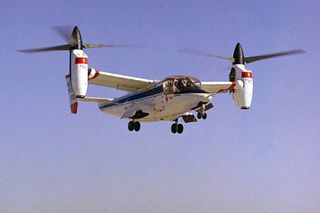Space History Photo: Tiltrotor Research Aircraft Hovering

In this historical photo from the U.S. space agency, the NASA-Army-Bell XV-15 tiltrotor research aircraft hovered (1976) and then demonstrated conversion and forward flight (1978) as the first tilting rotor vehicle to solve the problems of "prop whirl."
Through tremendously difficult research, the tilt rotor aircraft was able to combine the advantages of vertical liftoff and landing capabilities, which are inherent to the traditional helicopter, with the forward speed and range of a fixed wing turboprop airplane. This research can eventually lead to providing the aviation transportation industry with the flexibility for high-speed, long-range flight, united with runway-independent operations, thereby significantly relieving airport congestion.
The research success so far has directly led to the V-22 Osprey development. For more information, please see NASA History Monograph 17, The History of the XV-15 Tilt Rotor Research Aircraft: From Concept to Flight by Martin Maisel.
Each weekday, SPACE.com looks back at the history of spaceflight through photos (archive).
Get the Space.com Newsletter
Breaking space news, the latest updates on rocket launches, skywatching events and more!
Join our Space Forums to keep talking space on the latest missions, night sky and more! And if you have a news tip, correction or comment, let us know at: community@space.com.

The National Aeronautics and Space Administration (NASA) is the U.S. government agency in charge of the civilian space program as well as aeronautics and aerospace research. Founded in 1958, NASA is a civilian space agency aimed at exploring the universe with space telescopes, satellites, robotic spacecraft, astronauts and more. The space agency has 10 major centers based across the U.S. and launches robotic and crewed missions from the Kennedy Space Center in Cape Canaveral Florida. It's astronaut corps is based at the Johnson Space Center in Houston. To follow NASA's latest mission, follow the space agency on Twitter or any other social channel, of visit: nasa.gov.
